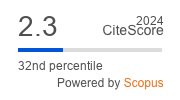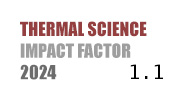THERMAL SCIENCE
International Scientific Journal
MECHANISM AND EXPERIMENTAL STUDY OF BIMETALLIC SOLID CATALYSTS ON UREA CATALYTIC HYDROLYSIS TO AMMONIA
ABSTRACT
In order to solve the problems of slow reaction rate and large reactor volume of traditional urea hydrolysis to ammonia, the urea catalytic hydrolysis was studied in this paper. The bimetallic solid catalyst TiO2@Al2O3 was synthesized firstly, in which the mesoporous γ-Al2O3 was selected as substrate and the TiO2 was inserted into the active site. The solid catalyst was characterized by Raman spectroscopy and transmission electron microscopy, and the intermediates were qualitatively detected by liquid NMR H-spectroscopy and C-spectroscopy, which was combined with density functional theory calculations to analysis the mechanism of the bimetallic solid catalyst. Then, the kinetic and thermodynamic properties of the urea catalytic hydrolysis by solid catalyst were investigated on a batch reactor and a continuous operation pilot plant. The kinetic parameters of the catalytic hydrolysis reaction were measured, and the influences of different catalysts on the hydrolysis reaction temperature, energy consumption and variable load response time were researched. The bimetallic solid catalyst proposed in this study can solve the problems of phosphorus-containing wastewater discharge and insufficient active sites of traditional catalysts, and will provide significant reference to the research of urea catalytic hydrolysis to ammonia for flue gas denitrification.
KEYWORDS
PAPER SUBMITTED: 2024-05-28
PAPER REVISED: 2024-07-30
PAPER ACCEPTED: 2024-08-05
PUBLISHED ONLINE: 2024-08-31
THERMAL SCIENCE YEAR
2025, VOLUME
29, ISSUE
Issue 2, PAGES [811 - 822]
- Yao, X., et al., Characteristics of Urea Hydrolysis Equipment for Flue Gas Denitration, Proceeding of the CSEE, 33 (2013), 14, pp. 38-43
- Sahu, J. N., et al., Response Surface Modelling and Optimization for Production of Ammonia from Urea in a Batch Reactor, Chemical Engineering, 4 (2009), 4, pp. 462-470
- Mahalik, K., et al., Statistical Modelling and Optimization of Hydrolysis of Urea to Generation Ammonia for Flue Gas Conditioning, Journal of Hazardous Materials, 182 (2010), 1, pp. 603-610
- Zheng, P., et al., Design Guidelines for Urea Hydrolysers for Ammonia Demand of the SCR DENOX Project in Coal-Fired Power Plants, Energy, 7 (2013), 1, pp. 127-132
- Young, D. C., Transporting Urea for Quantitative Conversion into Ammonia, United States Patent: 5252308, 1993-10-12, 1993
- Mahalik, K., et al., Equilibrium Studies on Hydrolysis of Urea in a Semi-Batch Reactor for Production of Ammonia to Reduce Hazardous Pollutants from Flue Gases, Journal of Hazardous Materials, 164 (2010), 2-3, pp. 659-664
- Yang, W., et al., Catalytic Performance of Zeolites on Urea Thermolysis and Isocyanic Acid Hydrolysis, Industrial and Engineering Chemistry Research, 50 (2013), 13, pp. 7990-7997
- Eichelbaum, M., et al., The Impact of Urea on the Performance of Metal Exchanged Zeolites for the Selective Catalytic Reduction of NOx: Part I, Pyrolysis and Hydrolysis of Urea Over Zeolite Catalysts, Applied Catalysis B: Environmental, 97 (2010), 1, pp. 90-97
- Guo, C., et al., Rapid in Situ Synthesis of MgAl-LDH on η-Al2O3 for Efficient Hydrolysis of Urea in Wastewater, Journal of Catalysis, 395 (2021), Mar., pp. 54-62
- Fan, X., et al., Plasma-Catalytic Hydrolysis of Urea for Ammonia Production: Optimization and Kinetic Study, Industrial and Engineering Chemistry Research, 60 (2021), 48, pp. 17480-17488
- Kuntz, C., et al., Deposition and Decomposition of Urea and Its by-Products on TiO2 and VWT-SCR Catalysts, International Journal of Heat and Fluid-Flow, 95 (2022), 108969
- Meguerdichian, A. G., et al., Synthesis and Electrocatalytic Activity of Ammonium Nickel Phosphate, [NH4] NiPO4·6H2O, and β-Nickel Pyrophosphate, β-Ni2P2O7: Catalysts for Electrocatalytic Decomposition of Urea, Inorganic Chemistry, 57 (2018), 4, pp. 1815-1823
- Bernhard, A. M., et al., Catalytic Urea Hydrolysis in the Selective Catalytic Reduction of NOx: Catalyst Screening and Kinetics on anatase TiO2 and ZrO2, Catalysis Science and Technology, 3 (2013), 4, pp. 942-951
- Sahu, J. N., et al., Equilibrium and Kinetic Studies of in Situ Generation of Ammonia from Urea in a Batch Reactor for Flue Gas Conditioning of Thermal Power Plants, Industrial and Engineering Chemistry Research, 48 (2020), 3, pp. 2705-2712
- Vander, K. S., et al., Multiparameter Determination of Thin Liquid Urea-Water Films, Applied Sciences-Basel, 11 (2021), 19, 8925
- Zheng, S., et al., On the Roles of Humidification and Radiation during the Ignition of Ammonia-Hydrogen-Air Mixtures, Combustion and Flame, 254 (2023), 112832
- Shen, S., et al., Catalytic Hydrolysis of Urea from Wastewater Using Different Aluminas by a Fixed Reactor, Environmental Science and Pollution Research, 21 (2014), June, pp. 12563-12568
- Ying, W., et al., In Situ Growth of Highly Active MgAl Layered Double Hydroxide on η-Al2O3 for Catalytic Hydrolysis of Urea in Wastewater, Catalysis Letters, 148 (2018), May, pp. 1893-1903
- Zhang, X. Y., et al., Experimental Study On Urea Hydrolysis To Ammonia For Gas Denitration In A Continuous Tank Reactor, Energy, 126 (2017), May, 126, pp. 677-688
- Wang, S., Simulation Research on Absorption Refrigeration System Based on NH3-H2O-LiBr Vapor-Liquid Equilibrium Calculation Model, Thermal Science, 26 (2022), 2C, pp. 1825-1840
- Ma, Y., et al., Urea-Related Reactions and Their Active Sites over Cu-SAPO-34: Formation of NH3 and Conversion of HNCO, Applied Catalysis B: Environmental, 227 (2018), July, pp. 198-208
- Wang, D, et al., A Review of Urea Pyrolysis to Produce NH3 Used for NOx Removal, Journal of Chemistry, 2019 (2019), ID6853638

